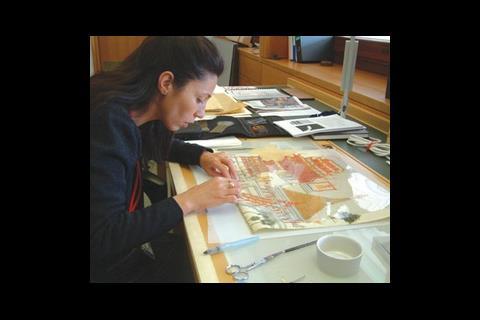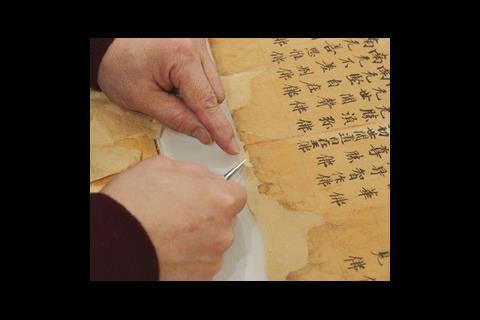Next year, the British Library is to reveal a first edition of a different sort: the world’s first building constructed specifically for book conservation. Doug King explains its environmental design
The British Library, already one of the world’s leading research libraries, is to distinguish itself in another way when it opens its own Centre for Conservation – the world’s first building constructed specifically for book conservation.
The library has an extensive collection of information recorded on every format from oracle bones to bytes, including manuscripts, maps, newspapers, music scores and patents. The material held dates back to about 1100 BC, covers most known languages and includes treasures such as the Magna Carta, one of Leonardo da Vinci’s notebooks, Beatles manuscripts and the recording of Nelson Mandela’s trial speech. This presents huge challenges for the Library’s conservation departments, which handle work ranging from the routine repair of books to the conservation of writing materials including parchment and vellum, papyrus, palm leaves and birch bark.
The decay processes for paper, cardboard and leather, all being organic materials, are similar. They generally involve either chemical or fungal breakdown, but can also involve mechanical or thermal stresses. Of equal importance here is the chemical or photochemical induced breakdown of the inks and pigments in the books. As most decay of organic materials is stimulated by heat or humidity, it has become normal to store archive material at low temperatures in dark, humidity-controlled environments and the British Library has over 625 km of shelving, all maintained under carefully controlled environmental conditions.
Figure 1 indicates the relative survival of books stored at reduced temperatures, from which it can be seen that the temperature has to be quite low in order to make a significant change in lifespan. In reality, library collections have to be stored at higher temperatures in order to avoid thermal shock when books are removed from storage for study. The British Library Reading Rooms are conditioned to 21ºC for the benefit of readers and the storage temperature for the reference collection has been adjusted to 19ºC, based on the curators’ experience in minimising shock to the books.
The bulk of the work undertaken by the British Library conservation department is in the repair and strengthening of volumes in the reference collections, to extend their lives and enable continued access by readers. This level of refurbishment is fundamentally different from the requirement to conserve historic volumes in their original forms, which also forms an important part of the work.
A question of balance
From the outset of this project, the team wanteded to ensure that the environmental conditions of the Centre for Conservation should be appropriate for undertaking the active conservation of the reference collection as well as handling the most valuable items. It being the first building in the world constructed specifically for book conservation, there were no precedents to go by and King Shaw Associates was asked to help develop a brief for the environmental design of the building.
In selecting suitable environmental conditions, we took a risk analysis-based approach. Research by Professor David P Wyon (see figure 2) has demonstrated a direct link between workplace performance, accidents and temperature based on loss of manual dexterity at the cold end of the spectrum and loss of mental acuity at the warm end. We felt that there was a clear argument here for evaluating the design temperature for the Centre in the light of both the potential for accidental damage to delicate items through loss of finger dexterity as well as the reduction in survival of the books from being held for two to four weeks in conditions outside the ideal storage environment.
Finger sensitivity and dexterity decreases below 24ºC, but at this temperature the rate of deterioration of the books is double that at the 19ºC storage temperature. Conversely, at 19ºC finger dexterity is reduced by about 15%, which results in an increased risk of accidental damage. Ultimately, it was decided to operate the Centre at 21ºC, but with the provision to match the temperature of the book stacks in limited areas if necessary. In this way, the anticipated reduction in a book’s life would be in the same order as the time taken to conserve it, whilst the conservation process may extend its life by tens or hundreds of years.
Similar reasoning was applied to the control of relative humidity. Paper leaves within a book, on a shelf, may take weeks to respond to a change in humidity. By comparison, during the process of refurbishment books are often disassembled and washed to remove acidic deposits from the papers. This will take the paper from equilibrium with the environment to saturation and back again in a period of less than 24 hours. Not only does this factor make the close control of space humidity seem pretty pointless, but the paper is subsequently air-dried in the studio, releasing quantities of moisture that would require very large and expensive dehumidification plant to control.
In the end we decided, as the paper is taken to saturation and back again in the conservation process, to incorporate this issue into the environmental strategy. When the books travel from the book stacks into the Centre, they will be passed through a succession of intermediate environments and allowed to acclimatise. New materials, such as endpaper, boards and leather bindings are also acclimatised so that when they are brought together with the paper, all components are at the same condition. Finally the refurbished book is returned to the book stacks through the same succession of intermediate environments.
Some light reading
Control of the lighting in the conservation workshops also presented an interesting conundrum. It has always been accepted that conservation work is best done under daylight, but this can expose materials to daylight levels in excess of 1000 lux, potentially exceeding the exposure limits for sensitive materials by 25 times. Once again, the argument is applied that the active process of conservation is of greater benefit to the material than the short period of over-exposure. The Centre for Conservation is currently under construction, due for completion in March 2007.
Design and construct consortium: Sir Robert McAlpine with Long and Kentish
as architects
Building services, structural and acoustic design: Arup
Project manager: Drivers Jonas
Technical support: King Shaw Associates
Downloads
Source
Building Sustainable Design






















No comments yet